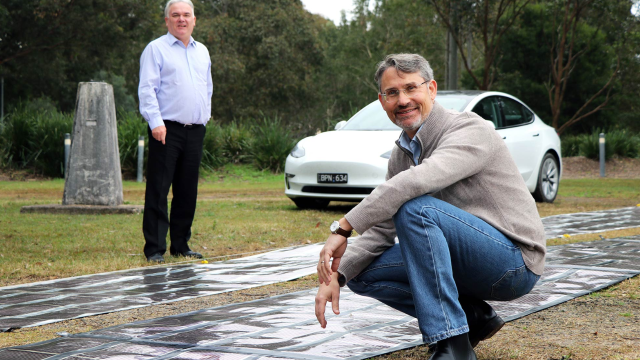Printed, easily transported solar cells could be the future of charging electric vehicles in Australia, as an advocate begins a road trip around the country with the assistance of the University of Newcastle.
Stuart McBain, the first person to circumnavigate the UK and Iceland in an electric vehicle, is leading the project, with driver Thilo Kober taking a Tesla Model 3 around the entire coastline of Australia with portable solar cells for charging. The campaign is called Charge Around Australia.
The campaign involves a live map, with a percentage readout indicating how much of the car has been charged by solar energy.
The purpose? To assess how accessible charging infrastructure is across Australia, but also to see if printed solar cells could be a solution for charging electric vehicles when charging stations aren’t available. Recently, electric vehicle charging stations have received a lot of criticism for not being widely available in the bush, but projects like this seek to bridge the gaps.
“My goal here in Australia is to contribute to the national conversation on decarbonisation by stimulating conversations about EVs and having honest conversations about the supporting infrastructure,” McBain said.
“I was frustrated by the range anxiety that was limiting EV uptake across Europe and wondered if I could help reframe public opinion and understanding. In Australia, as is the case for most developed countries, transport accounts for the highest levels of CO2 emissions, so as nations look to decarbonise, this is a sector that requires our urgent attention.”
The 15,097km journey will follow the coastline of Australia, with the added goal of informing charging infrastructure rollouts in dead spots throughout Australia.
Additionally, the electric vehicle will be charged by solar cells, an energy solution that seems terrific within Australia, where solar is always in supply. The cells are manufactured by Kardinia Energy.
“This is a rare and valuable opportunity for testing and feedback on our printed solar technology, in the field, in diverse environments. [Charging Across Australia] will not only help us refine our technology as we progress toward commercial roll-out, but may also help inform future designs and destinations for remote roadside charging stations aimed at solving the challenge of long-haul electric vehicle use in our country and others like it,” added University of Newcastle Professor Paul Dastoor, the developer of the printed solar cell technology.
It makes you wonder why solar energy hasn’t been used for electric vehicles widely before. For example, the Bridgestone Solar Challenge brings solar-powered vehicles to Australia from all over the world to compete — a famed entrant being the UNSW Sunswift car — but up until now, solar cell technology hasn’t been used on a commercial vehicle (to the exclusion of EV startup Lightyear).
With this latest project, 18 thin, retractable sheets will be available for the car to charge and easily restract inside the car when not used. They measure up to 20m x 1m.
They’re quite remarkable, actually. They’re created using conventional 2D printers and proprietary electronic inks. Supposedly it costs less than $10 per square metre to produce and the materials can be recycled.
“No other renewal energy technology can be manufactured as quickly. The low cost and speed at which this technology can be deployed is exciting as we need to find solutions, and quickly,” added Dastoor.
“Our aspiration here with [Charge Around Australia] was not the realisation of a specific consumer product, rather the acceleration of printed solar generally, as well as advocacy for important decarbonisation pathways.”
When the Tesla has a low battery, the sheets will charge the car for 10 hours, to power the drive for the next day, several times across the journey. That’s quite a lengthy amount of time, but it’s still a technology in development.
“As we continue to work on their efficiency, we’ll need less of them to achieve the same result. At this stage, applications are more suited to large commercial or factory roofs, or larger-scale fixed roadside locations, but eventually the cells could be incorporated seamlessly into the coating of the vehicle itself,” Dastoor said.
The journey officially began on September 4 although the live map hasn’t been updated yet. A spokesperson told Gizmodo Australia that the car should be arriving in Byron Bay today after starting in Brisbane.
You can read more on the University of Newcastle website or on the Charge Around Australia website.
